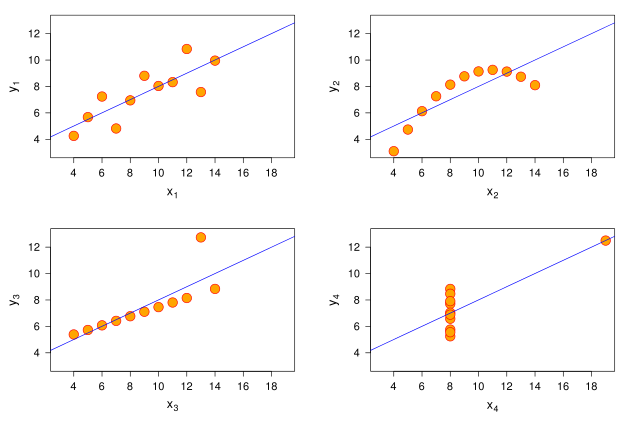
File:Anscombe.svg

| |
This is a file from the Wikimedia Commons. Information from its description page there is shown below.
Commons is a freely licensed media file repository. You can help. |
Summary
This graphic represents the four datasets defined by Francis Anscombe for which some of the usual statistical properties (mean, variance, correlation and regression line) are the same, even though the datasets are different.
| Property | Value |
|---|---|
Mean of each  variables variables |
9.0 |
Variance of each  variables variables |
11.0 |
Mean of each  variables variables |
7.5 |
Variance of each  variables variables |
4.12 |
Correlation between each  and and  variable variable |
0.816 |
| Regression line |  |
The graph was created by User:Schutz for Wikipedia on 13 June 2006 (and updated on 29 March 2010), using the R statistical project. The program that generated the graphic is given below; it is based on the example provided with the help page of the R dataset anscombe (accessible using the command data(anscombe)>; help and more information about the dataset is available using the command help(anscombe)), and was slightly modified to improve the result. The graph was directly exported in SVG format.
References:
- Anscombe, Francis J. (1973) Graphs in statistical analysis. American Statistician, 27, 17–21.
- R Development Core Team. R: A Language and Environment for Statistical Computing. R Foundation for Statistical Computing. Vienna, Austria. 2006. ISBN 3-900051-07-0. http://www.R-project.org
svg("anscombe.svg", width=10.5, height=7)
par(las=1)
##-- some "magic" to do the 4 regressions in a loop:
ff <- y ~ x
for(i in 1:4) {
ff[2:3] <- lapply(paste(c("y","x"), i, sep=""), as.name)
## or ff 2 <- as.name(paste("y", i, sep=""))
## ff 3 <- as.name(paste("x", i, sep=""))
assign(paste("lm.",i,sep=""), lmi <- lm(ff, data= anscombe))
}
## Now, do what you should have done in the first place: PLOTS
op <- par(mfrow=c(2,2), mar=1.5+c(4,3.5,0,1), oma=c(0,0,0,0),
lab=c(6,6,7), cex.lab=1.5, cex.axis=1.3, mgp=c(3,1,0))
for(i in 1:4) {
ff[2:3] <- lapply(paste(c("y","x"), i, sep=""), as.name)
plot(ff, data =anscombe, col="red", pch=21, bg = "orange", cex = 2.5,
xlim=c(3,19), ylim=c(3,13),
xlab=eval(substitute(expression(x[i]), list(i=i))),
ylab=eval(substitute(expression(y[i]), list(i=i))))
abline(get(paste("lm.",i,sep="")), col="blue")
}
dev.off()
|
|
This chart was created with R. |
Licensing
The R project is licensed under the GPL ; since this image is a derived work of an example script provided with R, it is also licenced under the GPL.
However, all modifications made by User:Schutz are also licensed under the CC-BY-SA licence.
 |
This work is free software; you can redistribute it and/or modify it under the terms of the GNU General Public License as published by the Free Software Foundation; either version 2 of the License, or any later version. This work is distributed in the hope that it will be useful, but without any warranty; without even the implied warranty of merchantability or fitness for a particular purpose. See version 2 and version 3 of the GNU General Public License for more details.http://www.gnu.org/licenses/gpl.htmlGPLGNU General Public Licensetruetrue |
Derivative works
Derivative works of this file:
File usage
Metadata
| Width | 756pt |
|---|---|
| Height | 504pt |
Background information
Schools Wikipedia has made the best of Wikipedia available to students. SOS Children helps more than 2 million people across 133 countries around the world. Find out how you can help children in other countries.
